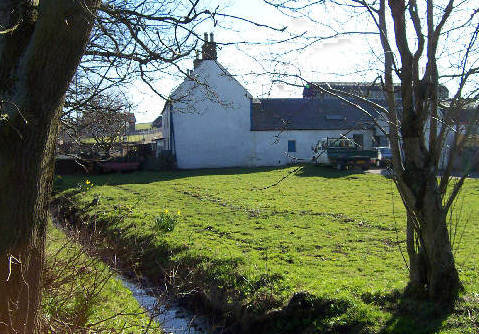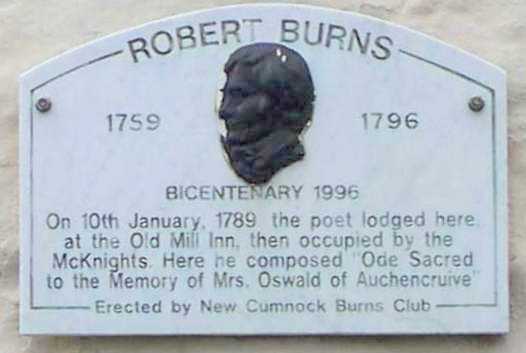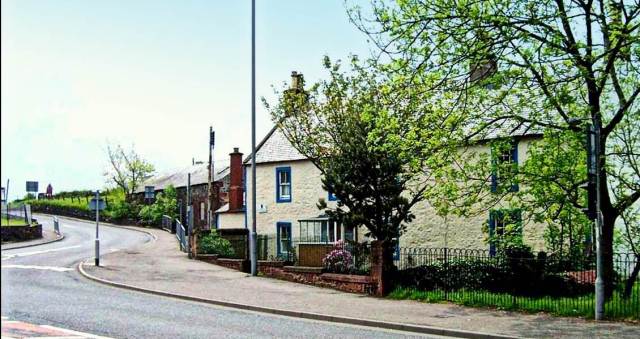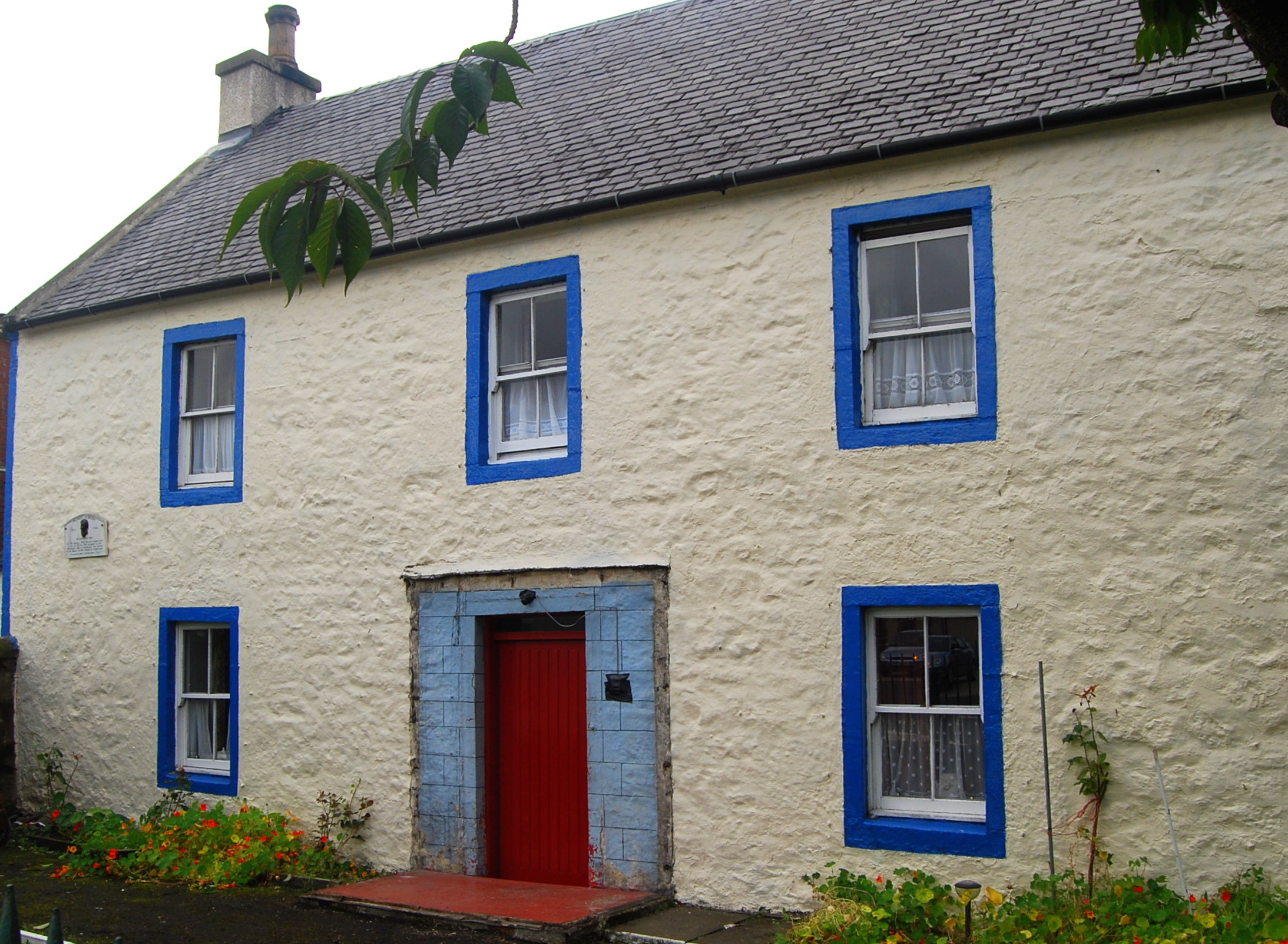
New Cumnock was a convenient stopping-off place for Robert Burns on his regular journeys between Mauchline and Ellisland. Here his horse could be fed and stabled overnight whilst he doubtless enjoyed the hospitality in one of the local Inns, either the Old Mill Inn or the Castle Inn. Local tradition suggests that he wrote ‘Sweet Afton’ at one of these Inns after having visited his friend John Logan at Laight in the picturesque Glen Afton.
It was during a forced overnight stay at the Old Mill Inn, New Cumnock on the 10th January 1789 that Burns penned his bitter ode to the memory of the late Mrs. Oswald. He had never met the lady when she was alive but knew of her only by reputation ‘ among her servants and tenants I know that she was detested with the most heart-felt cordiality’ [Letter to Dr. Moore]. Forced out of the Inn at Sanquhar to make way for her funeral pageantry as it made its way to the Oswald family plot at St.Quivox, Burns’ boiling blood may have help keep the wintry chillout as he travelled an unplanned extra 12 miles to New Cumnock.
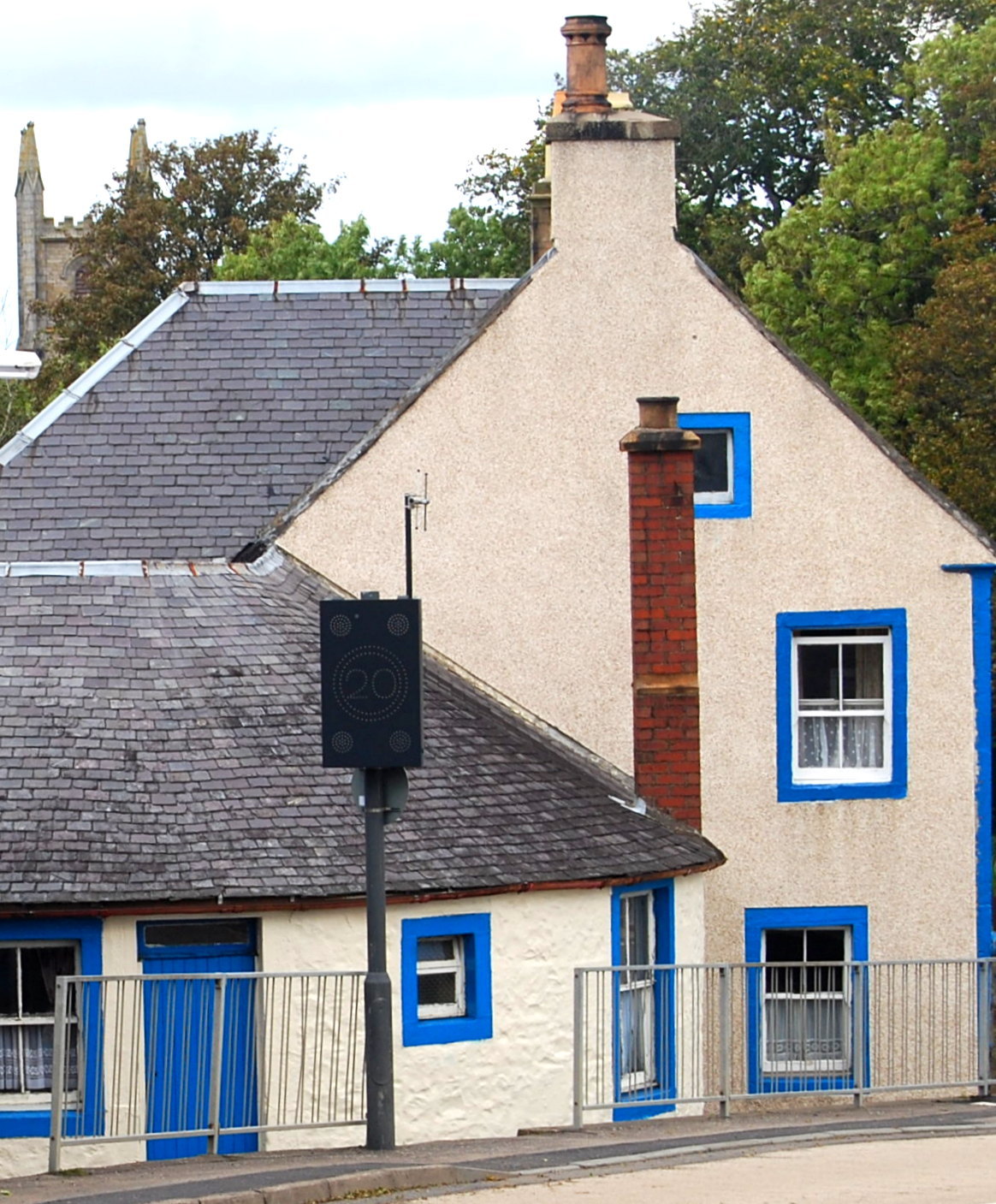
Letter to Dr. John Moore
In January last, on my road to Ayrshire, I had put up at Bailie Whigham’s in Sanquhar, the only tolerable inn in the place. The frost was keen, and the grim evening and howling wind were ushering in a night of snow and drift. My horse and I were both much fatigued with the labors of the day, and just as my friend the Bailie and I, were bidding defiance to the storm over a smoking bowl, in wheels the funeral pageantry of the late great Mrs Oswald, and poor I am forced to brave all the horrors of the tempestuous night, and jade my horse, my young favorite horse, whom I had just christened Pegasus, twelve miles farther on, through the wildest moors and hills of Ayrshire, to New Cumnock, the next Inn. The powers of Poesy and Prose sink under me, when I would describe what I felt. Suffice it to say, that when a good fire at New Cumnock had so far recovered my frozen sinews, I sat down and wrote the enclosed Ode.’ Robert Burns, 22nd March, 1789.

Ode
Dweller in yon dungeon dark,
Hangman of creation! mark,
Who in widow-weeds appears,
Laden with unhonour’d years,
Noosing with care a bursting purse,
Baited with many a deadly curse?
Strophe
View the wither’d Beldam’s face;
Can thy keen inspection trace
Aught of Humanity’s sweet, melting grace?
Note that eye, ’tis rheum o’erflows;
Pity’s flood there never rose,
See these hands ne’er stretched to save,
Hands that took, but never gave:
Keeper of Mammon’s iron chest,
Lo, there she goes, unpitied and unblest,
She goes, but not to realms of everlasting rest!
Antistrophe
Plunderer of Armies! lift thine eyes,
(A while forbear, ye torturing fiends;)
Seest thou whose step, unwilling, hither bends?
No fallen angel, hurl’d from upper skies;
‘Tis thy trusty quondam Mate,
Doom’d to share thy fiery fate;
She, tardy, hell-ward plies.
Epode
And are they of no more avail,
Ten thousand glittering pounds a-year?
In other worlds can Mammon fail,
Omnipotent as he is here!
O, bitter mockery of the pompous bier,
While down the wretched Vital Part is driven!
The cave-lodged Beggar,with a conscience clear,
Expires in rags, unknown, and goes to Heaven.
The McKnights of Old Mill
Prior to the division of the parish of Cumnock into the parishes of New Cumnock and Old Cumnock in 1650 the Old Mill ,the chief mill of the barons of Cumnock, was known as the ‘Mylne of Cumnock’.A sluice upstream diverted water from the Afton Water by way of a mill-lead (or lade) to fill the mill pond in preparation for turning the water wheel and the millstones. The mill-lead then run in front of the Old Mill farm and later behind the back of the castle before draining into the River Nith.
The earliest recorded miller was a John McNacht who in 1608 was set upon by the Craufurds of Auchincross and forced to hand over £20 – a small fortune – for fear of his life. His descendant, John McNaught was one of the many parishioners interrogated during Covenanting times of the late 17th century. A third John McKnight lived at the Old Mill Farm in the early 18th century,
His eldest George McKnight and his wife Betty Mitchell kept an inn in the farmhouse and it was here that Burns lodged and penned his poisonous ode. Their eldest son John McKnight was the last of the McKnights of the Old Mill, while another son William was the innkeeper at the Castle Inn and his widow Agnes was later innkeeper at the Crown Inn.
The Mill, The Mill O
The Old Mill farm house stands at the Toll overlooking the junction of the roads from Cumnock, Dalmellington and Dumfries. It sits at the foot of a small brae known locally as Shilling Hill. No this wasn’t the toll charge to use the road but is simply a corruption of the Scots sheilin hill , a hill where grain is winnowed and freed from the husk.
In his chapter on New Cumnock in his ‘Notes on the Way through Ayrshire’ George McMichael writes ‘ the Old Mill and Shelling Hill, by oral tradition the scene of the very old song, “The Mill, Mill, O,” a version of which was written down by Burns.
The Mill, Mill, O
‘As I cam doon yon water side,
An’ by yon Sheilin’ Hill, O,
There I spied a bonnie, bonnie lass,
An’ a lass I lov’d richt weel, O.
The mill, mill, O, an’ the kill, kill, 0,
An’ the coggin’ o’ Peggy’s wheel, O-
The seek an’ the sieve, an’ a’ she did leave,
An’ danced the miller’s reel, O.‘
Sadly little now remains of the mill buildings while the mill pond was filled in during the 1970’s gone forever the wonderful Sunday walks along the lade burn from the sluice at the Afton to the mill pond .
